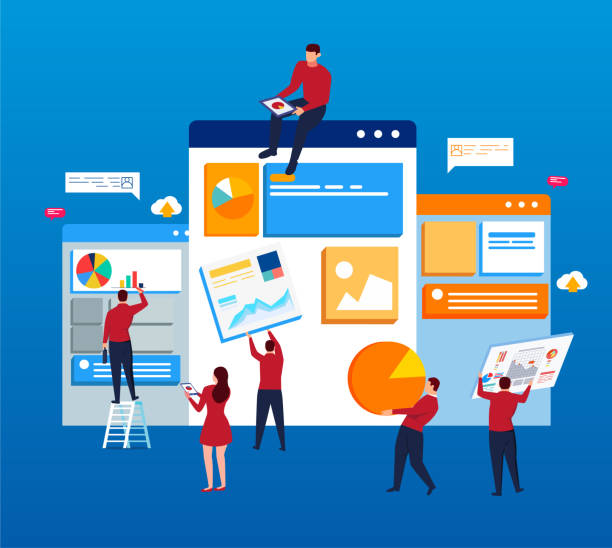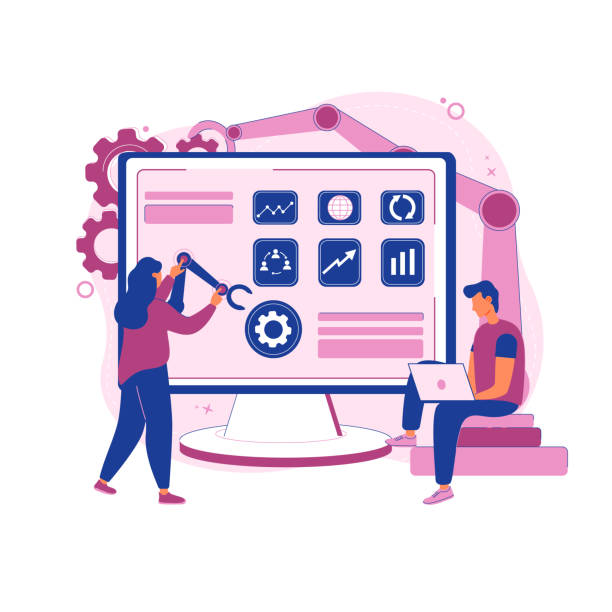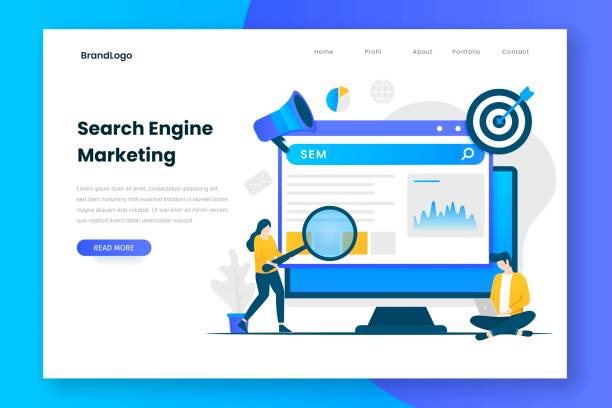The Importance of Fast Website Design in the Digital Age

In today’s world, where speed is paramount, #Fast_Website_Design is no longer an option, but an undeniable necessity.
Internet users have little patience, and statistics show they wait no more than a few seconds for a website to load.
If your website is slow, you not only provide a poor user experience, but you also lose the chance to attract potential customers and achieve a high ranking in search engines.
The goal of fast website design is to deliver content to the user as quickly as possible to prevent a high bounce rate.
This is particularly crucial for business and e-commerce websites, as every second of delay can mean lost sales.
High loading speed not only leads to user satisfaction but also sends a positive signal to search engines like Google that your website offers more value to users.
This directly affects your SEO and site ranking in search results.
The process of website speed optimization involves numerous techniques and tools, ranging from image compression to server-side code optimization.
In fact, investing in website speed is investing in the success of your online business.
Ignoring this factor can lead to failure in today’s competitive market.
Therefore, developers and business owners must understand the importance of this issue and plan to improve it.
Even the smallest improvements in loading time can make a big difference in overall site performance and help you surpass your competitors.
This is a long-term investment that will yield significant returns.
Worried about losing customers because you don’t have a professional e-commerce site?
With e-commerce website design by Rasaweb, forget these worries!
✅ Significant increase in sales and conversion rate from visitor to customer
✅ Professional and user-friendly design that builds customer trust
⚡ Get free consultation from Rasaweb
The Impact of Loading Speed on User Experience and Google Ranking

Website loading speed is the backbone of a desirable user experience and a determining factor in search engine rankings.
In this section, we will delve deeper into this topic analytically.
When a user clicks on a link, they expect the page to load instantly.
Any delay, even a fraction of a second, can lead to an increase in Bounce Rate; meaning the user leaves the page before seeing the content.
According to Google research, with every second of loading delay, the bounce rate can increase by up to 20 percent.
This not only means losing a potential visitor but also signals to search engines that your website provides a poor user experience.
On the other hand, fast loading speed leads to user satisfaction and encourages users to spend more time on your site, view more pages, and interact more with your content.
This user behavior (such as dwell time and number of pages viewed) is considered an important factor in Google’s ranking algorithms.
Google has officially announced that website loading speed is one of the main factors in ranking search results.
The company has introduced Core Web Vitals, specific metrics for measuring the quality of user experience, including loading speed.
These metrics include LCP (Largest Contentful Paint) for measuring the loading speed of the main content, FID (First Input Delay) for measuring the site’s responsiveness to user input, and CLS (Cumulative Layout Shift) for measuring the visual stability of the page.
Websites that perform better on these metrics will have a greater chance of achieving higher rankings in search results.
A fast website design directly impacts these metrics positively.
Furthermore, in today’s mobile-centric world, loading speed on mobile devices is particularly important.
Mobile users often connect to slower internet and have more limited storage and processing power.
Therefore, a website must be designed to load quickly on all devices and with any type of internet connection.
This is not only crucial for mobile SEO but also affects the Conversion Rate.
If your e-commerce website is slow, users will abandon their shopping carts and go to competitors.
Therefore, investing in website speed is not just a technical action but a vital strategy for the growth and sustainability of your online business.
Technical Factors Affecting Website Speed Optimization

To achieve #Website_Speed_Optimization and deliver a fast-loading website, understanding and managing underlying technical factors is of paramount importance.
These factors are a set of specialized and targeted actions applied to reduce website loading time.
The first and perhaps most important factor is image optimization.
High-volume images can place a heavy load on server bandwidth and the user’s browser.
Using appropriate formats (such as WebP), intelligent compression, and Lazy Loading of images are essential steps in this regard.
The second factor is Minification or reducing the size of HTML, CSS, and JavaScript codes.
By removing white spaces, comments, and unnecessary characters, file sizes are reduced, and loading speed increases.
This optimization process is essential for any fast website design.
The third factor is browser cache.
By enabling browser cache, static website files (such as CSS, JS, and images) are stored in the user’s browser on the first visit, and in subsequent visits, there is no need to download them again, which significantly contributes to reload speed.
The fourth factor is Server Response Time.
A slow server or improper configuration can spend a lot of time sending the first byte (TTFB).
Database optimization, using high-speed servers, and choosing suitable hosting are effective in this regard.
The fifth factor is the use of CDN (Content Delivery Network).
CDN distributes website content across various servers worldwide, allowing users to receive content from the nearest server, which dramatically increases loading speed.
The sixth factor is optimizing fonts and icons.
Using web fonts with optimized formats and loading subsets of fonts instead of entire fonts can reduce font file sizes.
These technical measures are the main pillars of a fast website design, and their correct implementation requires specialized knowledge and continuous monitoring.
The table below refers to some of these factors and their related solutions.
| Technical Factor | Explanation | Optimization Solution |
|---|---|---|
| Image Size | High quality and large size images | Compression, WebP format, Lazy Loading, Responsive dimensions |
| Extra Codes (HTML, CSS, JS) | White spaces, comments, and duplicate codes | Minification, file concatenation, removing unused codes |
| Browser Caching | Lack of static file storage by browser | Enabling Expire Headers, using ETag |
| Server Response Time | Delay in sending the first byte of content from the server | Database optimization, hosting upgrade, using new PHP version |
| Using CDN | Not using a content delivery network | Implementing CDN for static files |
Website Speed Measurement and Performance Analysis Tools

To identify the strengths and weaknesses of a website in terms of #Website_Speed and succeed in fast website design, using performance measurement and analysis tools is essential.
These tools provide accurate and practical reports, helping you identify bottlenecks and take necessary actions to improve them.
One of the most widely used tools is Google PageSpeed Insights.
Provided by Google, this tool checks Core Web Vitals related metrics for both desktop and mobile versions of your website.
Its report includes scores for performance, accessibility, best practices, and SEO, offering suggestions for improvement.
These reports might include fixing render-blocking resources or optimizing images.
Another tool, GTmetrix, provides comprehensive information, including a Waterfall Chart.
The Waterfall Chart shows you how much time each website resource (images, CSS and JS files, etc.) takes to load and which ones are the slowest.
GTmetrix also provides PageSpeed and YSlow scores along with improvement suggestions.
This tool is very valuable for anyone looking to optimize website speed.
Lighthouse, an open-source tool from Google also available in the Chrome browser, is not limited to speed and also evaluates performance, SEO, accessibility, and development best practices.
The Lighthouse report is very detailed and can help you identify opportunities for improvement in various areas, including why your website is slow and how you can optimize it.
Pingdom Tools is another speed measurement tool that allows testing from different geographical locations, helping you understand website loading times for users in various parts of the world.
This tool also provides a Waterfall Chart and optimization recommendations.
For each of these tools, it is important to not only review the scores but also pay attention to the details of the suggestions.
Often, small improvements at several points lead to a significant increase in overall website speed.
Regular monitoring with these tools helps you continuously track your website’s performance and prevent speed drops.
In a fast website design, these tools play a vital role in diagnosing and resolving hidden issues.
Are you losing business opportunities due to an outdated website? With Rasaweb, permanently solve the problem of not attracting potential customers through your website!
✅ Attract more high-quality leads
✅ Increase brand credibility in the eyes of customers
⚡ Get a free corporate website design consultation
Optimizing Images and Media for Faster Loading

The #Image_Optimization and media section is a key aspect of achieving a fast website design.
Images and videos are often the heaviest elements of a web page and can significantly increase loading time.
The first step is choosing the right image format.
Formats like WebP, developed by Google, offer much better compression than JPEG and PNG and can reduce file size by up to 70%, while maintaining image quality.
JPEG is more suitable for photos and PNG for images with transparency or simple graphics, but even these formats need to be optimized.
Image compression without noticeable loss of quality is an art.
Many online tools and WordPress plugins exist for this purpose, allowing you to optimize images before or during upload.
In addition to format and compression, image dimensions are also important.
Always display images in the exact required dimensions and avoid uploading images that are much larger than what will be displayed.
Responsive Images are also an excellent solution that allows the browser to load the best image dimensions based on the user’s screen size.
Another effective technique is Lazy Loading.
With this feature, images and videos are only loaded when the user scrolls to the relevant section on the page and they enter the viewport (user’s visible area).
This significantly reduces the initial page load time, especially on pages with a lot of content and numerous images.
For videos, it is also better to embed videos from platforms like YouTube or Vimeo and avoid direct video uploads to your server.
These platforms perform the necessary optimizations for video streaming.
You can also use a video poster (Placeholder Image) to prevent the video from loading until the user decides to play it.
Finally, using a CDN for media hosting can help distribute them faster worldwide.
All these measures combined help you reduce the weight of your web pages and provide a fast-loading website to your users.
Ignoring these points can lead to reduced SEO ranking and user dissatisfaction, even if you perform well in other technical aspects of your website.
Reducing Code and Script Size to Increase Speed

#Minify_CSS and JavaScript are an integral part of the fast website design process.
HTML, CSS, and JavaScript codes form the backbone of any website.
But during the development process, these codes often include white spaces, comments, and extra characters that are useful for human readability but unnecessary for browsers and increase file sizes.
Minification means removing these extra characters without changing the code’s functionality.
This can significantly reduce file sizes and consequently increase loading speed.
For example, in CSS files, you can remove extra white spaces, comments, and trailing semicolons.
For JavaScript, in addition to removing white spaces, variable and function names can be changed to shorter ones (Obfuscation), although this is more complex and must be done carefully.
In addition to Minification, combining CSS and JavaScript files (Concatenation) can also be effective.
Instead of loading multiple separate CSS or JS files, they can be combined into a single file.
This reduces the number of HTTP requests to the server, which is an important factor in increasing loading speed.
However, it should be noted that with the advent of HTTP/2 and HTTP/3, this technique is less crucial than before, as these protocols can manage multiple requests in parallel.
But it is still useful for older browsers or websites that use HTTP/1.1.
Another important technique is loading JavaScript scripts asynchronously (Async) or deferred (Defer).
By default, when browsers encounter a <script> tag, they stop loading and executing until the entire script is loaded, which can cause “render-blocking” and delay the display of page content.
By using the `async` or `defer` attributes, the browser can be instructed to load the script in the background and allow the HTML content to be displayed.
This significantly helps improve LCP and FID and plays an important role in fast website design.
Continuous code optimization and cleanup not only help website speed but also make the code more organized and maintainable.
Choosing Suitable Hosting for a Fast-Loading Website

One of the most important decisions that directly affects #Website_Speed and success in fast website design is choosing suitable hosting.
Hosting, as the home of your website, is responsible for storing files and delivering them to users.
Inappropriate hosting can slow down even the most optimized codes and images.
There are different types of hosting, including shared hosting, VPS (Virtual Private Server), dedicated server, and cloud hosting.
Each has its advantages and disadvantages.
Shared hosting is the cheapest option, but server resources are divided among multiple websites, which can lead to reduced speed, especially if one of the neighboring websites has a lot of traffic.
For a fast-loading website with moderate to high traffic, VPS or a dedicated server are better options, as they provide more dedicated resources.
In addition to the type of hosting, other factors must also be considered.
Server’s physical location is very important; your website should be hosted on a server that is closest to your target audience to minimize data travel time (latency).
For Iranian audiences, choosing hosting with servers inside Iran or neighboring countries can significantly increase loading speed.
Using SSD drives instead of HDDs in servers also plays a vital role in data read and write speeds and helps pages load faster.
The bandwidth and RAM and CPU resources provided by the hosting must also be commensurate with your website’s needs.
Managed Hosting is also a popular option for many businesses, as it delegates server optimization, security, and updates to the hosting company, allowing you to focus on content.
Some managed hosting providers are specifically optimized for WordPress or other CMSs and offer features such as server-level caching and internal CDNs, which contribute to website speed.
Choosing hosting with strong and reliable technical support is also essential so that if a problem occurs, you can quickly resolve it.
Ultimately, the quality and server speed are the foundation of a high-speed website, and without it, all software optimizations will lose their effectiveness.
The table below provides a comparison of hosting types in terms of speed and cost.
| Hosting Type | Explanation | Speed (Approx.) | Cost (Approx.) |
|---|---|---|---|
| Shared Hosting | Shared resources with other websites | Medium to Slow | Low |
| VPS (Virtual Private Server) | Partitioned from a physical server with dedicated resources | Good to Very Good | Medium |
| Dedicated Server | A complete server exclusively for one website | Very Good | High |
| Cloud Hosting | Network of servers, high scalability | Excellent (as needed) | Variable (usually high for large resources) |
| Managed Hosting | Optimized hosting for specific CMS (e.g., WordPress) | Excellent (with internal optimizations) | High |
The Role of Content Management Systems and Frameworks in Site Speed

Choosing the right #Content_Management_System (CMS) or framework is another decisive factor in website loading speed and directly impacts your ability to achieve fast website design.
CMSs like WordPress, Joomla, and Drupal allow for rapid website development, but if not properly optimized, they can become a factor for site sluggishness.
WordPress, as the most widely used CMS globally, is renowned for its rich ecosystem of plugins and themes.
However, using heavy themes or installing too many poorly coded plugins can severely reduce site speed.
Many plugins and themes load additional CSS and JavaScript files, leading to increased HTTP requests and overall page size.
Therefore, when choosing themes and plugins, special attention should be paid to optimization for speed, and only essential items should be installed.
Using caching plugins (such as WP Super Cache or LiteSpeed Cache) in WordPress can also have a significant impact on loading speed, as they generate and serve static pages to users, reducing server-side processing.
Web development frameworks like React, Angular, and Vue.js have also gained popularity in recent years.
These frameworks enable the creation of Single Page Applications (SPA) that can provide a very smooth and fast user experience, but their initial loading may be slow due to the large volume of JavaScript.
Techniques such as Code Splitting and Server-Side Rendering (SSR) are crucial for these frameworks to optimize initial loading speed.
Code Splitting means dividing JavaScript code into smaller chunks that are loaded only when needed, and SSR means rendering the page on the server side before sending it to the browser, which reduces the initial content display time.
Additionally, using Headless CMS platforms alongside modern frameworks can also help improve speed, as in this approach, the backend (content) and frontend (user interface) are separated, providing more flexibility for frontend optimization.
Overall, whether you use a CMS or a framework, adhering to optimization principles, such as using optimized codes, minimizing HTTP requests, and proper caching, is essential for achieving a fast and efficient website design.
These principles must be considered at all stages of website development and maintenance.
Are you falling behind in the competition with large online stores?
Rasaweb, with its professional e-commerce website design, brings your business online and increases your market share!
✅ Increase brand credibility and customer trust
✅ Easy shopping experience leading to more sales
⚡ Act now to get a free website design consultation!
The Future of Fast Website Design and Emerging Technologies

The web world is constantly evolving, and with it, the concept of #Fast_Website_Design also evolves.
Emerging technologies are continuously changing how websites are built and delivered, and this trend will continue in the future.
One of the most important of these trends is the expansion of Progressive Web Apps (PWA).
PWAs combine the best features of websites and mobile applications, offering a fast, reliable, and engaging experience.
They have capabilities such as offline functionality, push notifications, and quick access to the home screen, which help improve user experience and speed.
The future of the fast-loading web is highly dependent on these approaches.
AMP (Accelerated Mobile Pages) is another Google project aimed at delivering incredibly fast web pages on mobile devices.
Although AMP has faced criticism, it remains an effective solution for news publishers and blogs seeking maximum speed.
Next-generation communication protocols, such as HTTP/3, will play a significant role in the future of web speed.
Built on QUIC, HTTP/3 can improve latency and packet loss issues compared to HTTP/2, potentially increasing loading speeds on unstable networks.
This protocol will be particularly beneficial for mobile users with variable internet connections.
Also, Serverless Functions technologies and Edge Computing are changing website architectures.
With serverless, developers don’t need to manage servers, and codes only execute when necessary.
Edge Computing also minimizes latency by bringing data closer to the end-user through advanced CDN networks.
These approaches will be particularly effective for complex and global web applications that require quick responsiveness.
Artificial intelligence and machine learning also hold great potential for automating website optimization.
Tools that can automatically compress images, remove unnecessary codes, or even modify website design for greater speed are under development.
The future of fast website design is moving towards websites that are not only fast but also intelligently and dynamically adapt to various network conditions and user devices.
Can these technologies completely solve current web speed challenges? That is a question that time will answer, but the path ahead is certainly towards a faster, more efficient, and more user-friendly web.
Successful Examples of Fast Website Design and Final Summary

In this engaging and analytical section, we will look at some successful examples of #Fast_Website_Design and finally provide a summary of the importance of this topic.
Many tech giants and large companies have understood the importance of speed, and their websites are prime examples of optimal performance.
For instance, major news websites like BBC News or The New York Times, which receive millions of visitors daily, constantly optimize themselves for fast content loading.
They use CDNs, advanced image compression, strong caching, and optimized codes so that their readers can quickly access news.
In the world of e-commerce, speed is of vital importance.
Amazon and eBay, where billions of dollars in transactions occur daily, have invested heavily in their website speed.
They know that every millisecond of delay can mean millions of dollars lost.
These sites use complex Microservices architectures, large-scale database optimization, and extensive CDN networks to ensure speed and stability.
There are also many successful domestic examples.
High-traffic e-commerce and service websites in Iran, understanding the importance of loading speed, are continuously optimizing their infrastructure.
These sites have improved user experience by using powerful servers, domestic and international CDNs, optimizing images and scripts, and implementing caching mechanisms.
They use website speed analyzers to identify and quickly resolve issues.
In final summary, it can be said that fast website design is no longer a luxury feature but a fundamental factor for success in the online space.
This issue not only affects user satisfaction and improved user experience, but also directly impacts site ranking in search engines, conversion rates, and ultimately business profitability.
The process of website speed optimization is not a one-time task but a continuous and ongoing effort that requires regular monitoring, analysis, and updates.
Given the increasing competition in the digital world, only websites that provide a fast and flawless user experience can succeed in the long run.
So, plan now to improve your website’s speed and reap its countless benefits.
This is an investment whose return will be valuable in every respect.
Frequently Asked Questions
| Question | Answer |
|---|---|
| What is fast website design? | It refers to the process of building a website that is developed and launched in a short period, typically using ready-made platforms or optimized methods. |
| Why is speed important in website design? | High speed improves user experience, increases SEO ranking, and boosts the conversion rate of visitors into customers. |
| What tools are available for fast website design? | Content Management Systems (CMS) like WordPress, Joomla, and Drupal, drag-and-drop website builders, and fast web development frameworks. |
| What are the advantages of using a CMS for fast design? | Ready-made templates, diverse plugins, easy content management without much coding, and a large user community for support. |
| Does fast website design mean low quality? | Not necessarily. With appropriate tools and methods, a high-quality website can also be designed quickly. |
| What factors affect website design speed? | Project complexity, designer’s experience, choice of platform or tool, readiness of content and images, and effective communication with the client. |
| How is responsive design considered in fast website design? | Most fast design templates and tools are responsive by default and require little or no configuration. |
| How much does fast website design cost? | The cost varies depending on complexity, chosen platform, and additional services, but is usually less than custom design from scratch. |
| How can the loading speed of a designed site be increased? | Image optimization, browser caching, file compression, CDN usage, and choosing suitable hosting. |
| When is fast website design a suitable option? | For small businesses, startups, personal websites, or projects that need quick launch and have a limited budget. |
And other services of Rasa Web Advertising Agency in the field of advertising
Smart Digital Advertising: Professional optimization for improved SEO ranking using custom programming.
Smart Data Analysis: A dedicated service for growth in click-through rates based on marketing automation.
Smart Sales Automation: A combination of creativity and technology to improve SEO ranking through SEO-driven content strategy.
Smart Conversion Rate Optimization: A new service for increasing online growth through SEO-driven content strategy.
Smart Sales Automation: A new service for increasing digital branding through user experience customization.
And over hundreds of other services in the field of internet advertising, advertising consultation, and organizational solutions
Internet Advertising | Advertising Strategy | Advertorials
Sources
Complete Guide to Responsive Design
Website Speed Optimization: Techniques and Tools
UI/UX Design for Fast-Loading Websites
The Impact of Hosting on Website Speed and Optimal Choice
? Ready to transform your business in the digital world? Rasaweb Digital Marketing Agency, with expertise in comprehensive services including custom website design, professional SEO, and targeted advertising campaigns, is your guide to success in the online space. With us, your brand will shine at its peak.
📍 Tehran, Mirdamad Street, next to Bank Markazi, Kazeroun Jonoubi Alley, Ramin Alley No. 6




